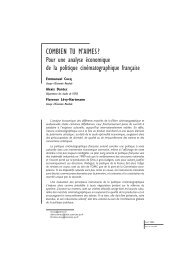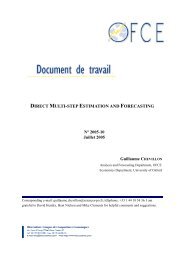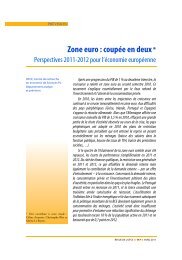N° 2005-09 Juin 2005 Guillaume Daudin* Jean-Luc Gaffard ...
N° 2005-09 Juin 2005 Guillaume Daudin* Jean-Luc Gaffard ...
N° 2005-09 Juin 2005 Guillaume Daudin* Jean-Luc Gaffard ...
You also want an ePaper? Increase the reach of your titles
YUMPU automatically turns print PDFs into web optimized ePapers that Google loves.
Relocation: What Matters? Competition or/and a New Policy Mixhence a decrease of the demand for goods of country 2 generating an excess capacity in thiscountry. The final result depends on the way necessary adjustments to re-establishcomplementarity take place in both countries.Investment must be carried out in region 2 and this takes time. It implies that revenueswill be distributed while the goods in which they will be spent cannot be provided out of thecurrent local output. Inflationary pressures and/or trade deficit will follow. Then the standardprescription consisting in fighting inflation and keeping prices flexible could result in cuttinginvestment spending, and aggravating distortions in the structure of productive capacity in thetwo regions (ibid.). A policy aimed at sustaining investment only in region 2 would favourthis region and likely generate an uneven development and a dualistic structure. However, ifin the country 1 the increase in demand due to the trading effect more than compensates theinitial decrease due to the preference shock, a policy mix may prove necessary in this countryas well, in order to allow investment in new capacity. Therefore, sustaining investment inboth countries would help absorbing the shock and prevent a too large gap between thegrowth rates of the two regions.In other words, complementary external demands (i.e. international trade) shouldstimulate faster growth in the exchanging countries. However, trade advantages can becaptured only if appropriate interventions for sustaining investment in new productionprocesses are realized in a context where demand complementarity adds to the complexity ofadjustments. Production, as often stressed (Amendola, <strong>Gaffard</strong> 1998), takes time, whichimplies distortions in productive capacity resulting in current market disequilibria inexchanging countries that try to adjust through investment. The restructuring of productivecapacity in the two countries has to be accommodated by transfers (or by an easing offinancing conditions) that allow the re-absorption of the shock. For these interventions not tobring about unbearable distortions in the structure of productive capacity, the balance betweeninvestment and consumption must be maintained, so as to allow each economy to reach athreshold beyond which complementarity of demand between countries becomes effective,smoothing fluctuations and thus resulting a growth factor. Then, relocation will only permit abetter allocation of resources, without adding to pre-existing distortions, and withoutinvolving development gap between countries.While new economic geography modelling tells us that change in fundamentals doesnot induce a change in the size of markets, sequential analysis reveals the existence ofdomestic distortions that affect reciprocal demands and generate perturbations in the growth73








